
This season will be our 7th offering seaweed programming at Smithereen Farm.
In advance of these sessions we have been compiling readings for attendees to prepare their minds for the lifeworld they will encounter below the tideline, and to participate in the commons-making learning activities.
Our explicit goal in hosting these sessions is to cultivate a culture of invitation, of inquiry, of deep commitment and ecological literacy, along with a healthy passion for the delicious food we are collecting from the wild.
The seaweed commons is a conceptual framework as well as a community learning project, and our central premise is that we as human actors have a role to play in defending the seaweed.
As we like to say "seaweed is already saving the world" but there are many potential threats to the health of this ecosystem, as we will learn from our west coast kelp paneliest describing the impact of ocean heat waves on their wild kelp forests.
How can we prepare ourselves to defend the kelp, from a policy perspective, but also in cultivating our will, our observation, and — as seaweed harvester Larch Hanson is fond of saying — our intuition.
To that end, Larch shared these readings:
https://maineseaweedharvesters.org/an-authentic-relationship-to-rockweed/
https://maineseaweedharvesters.org/everything-you-need-to-know-about-rockweed/
https://maineseaweedharvesters.org/harvest-guidelines/
https://maineseaweedharvesters.org/post-harvest-treatments/
https://maineseaweedharvesters.org/green-business/
https://maineseaweedharvesters.org/sustainability/
https://maineseaweedharvesters.org/to-market/
https://maineseaweedharvesters.org/fragile-and-rare-nori-dulse-bladderwrack/
https://maineseaweedharvesters.org/with-plants-there-are-no-boundaries-in-consciousness/
Position posted: December 2024
Position open until filled, with priority application review deadline January 5, 2025
Seaweed Commons is hiring for a part-time coordinator position. (We thank Elena Bird, who did such a wonderful job and is now working on a PHD.)
The qualifications for this position include:
- a familiarity with seaweed ecology and policy context either in the US or elsewhere
- a keen interest in working within community context and supporting local actors with needed materials and support for local actions.
- There is a preference for someone who is based either in BC, Alaska, Maine, or the Pacific Northwest, where U.S. aquaculture, mariculture and wild harvests are based, so as to be able to join physically with our network partners in learning events and conferences.
To apply: Applicants should send a letter of interest and resume to [email protected] these will be evaluated in the month of January 2025, and we will accept applications until the position is filled. Please pass along the word, we are also looking for steering committee members as we move forward into the coming year
Goals
We of Seaweed Commons are mostly smaller businesses (farmers and wild-harvesters) whose practices and ecological approaches best match the scale of the seaweed resource and its human and non-human context. We are joined by conservation-minded citizens, marine biologists, and especially coastal stakeholders whose solidarity can help shape the governance of our shared resources. We operate out of respect for the commons to which we belong, and according to principles laid down by Elinor Ostrum, winner of the 2009 Nobel Prize for her study of commons-based natural resource management.
In the course of our meetings within the Seaweed Commons community (since 2019) we have discerned the following priorities:
- Hosting an educational platform on the topic of appropriate seaweed harvest and farming.
- Creating and gathering materials for independent study for the benefit of coastal stakeholders and practitioners, producing media on this topic.
- Hosting listening and learning sessions within the community of seaweed harvesters and small scale farmers to continue sensing our direction as a collective.
- Taking a more active role to support diverse local actors at the (state fisheries level) in their efforts and advocacy for a more participatory policy process, that prioritizes owner operators, lessons learned from international context, protection of local wild food webs and of existing and indigenous coastal livelihoods.
- The major ongoing challenge for a sane and sensible seaweed economy is a headlong rush and “seaweed frenzy” as state and business actors race to scale. US Department of Energy grants, state aquaculture programs, venture capital and international corporations—all of these are focused on aquaculture intensification, privatization of leased waters and monopolizing sea space with gigantic operations. Towns and bays, marine biologists, and conservation lawyers do push back, and they share resources from fight to fight, with recent years showing significant wins against large actors with terrible practices, pollution, disease, and ocean crowding. (State of Washington, British Columbia, etc.)
Our basic task remains that of clarifying over and over again, the rationale for a small and medium-scale approach to seaweed harvest and aquaculture. Showing up at hearing sessions, writing letters to the editor, getting and accompanying good journalism, running open and inclusive educational events, communicating clearly with chefs, foodies, farmers and coastal citizens a view and a vision of what sensible seaweed economy can be with our white paper, our values statement and our forthcoming ‘ best practices, best players’ inventory.
2025 Educational Opportunities
Dakini Tidal Wilds (British Columbia) continues to host workshops and learning opportunities
Smithereen Farm (Downeast Maine) continues to host Low Low Tides days begin March 2025.
The Myco Buoy Project (Upstate New York / Maine) continues its program developing biodegradable flotation solutions for aquaculture.
25th Annual International Seaweed Symposium, May 4 – 9, 2025 | Victoria, British Columbia, Canada
What is your news?
How are you able to engage with policy process at this time? Do you need more tools or training on how to engage more powerfully with rule-making? Reach out: [email protected]
Banking on the Seaweed Rush
“We don’t have an adequate regulatory framework in Maine to protect us from very large-scale experiments by very well-funded actors,” says Severine von Tscharner Fleming, a wild seaweed harvester and organic farming advocate with the North American group Seaweed Commons. Meanwhile, she says, there’s a lot of money and rhetoric from companies that large-scale projects will absorb carbon and produce copious food without any negative impacts. “It sounds a lot like the sunny, optimistic projections from conventional agriculture that those of us in organic ag have spent our lives trying to confront,” she says. “That over-rosy outlook is uncomfortable.”
>> Read more here
Portland Press Herald
February 12, 2023
Maine’s cold water, abundant forests of rockweed and talented workforce make it a great place for seaweed aquaculture. That does not mean a ‘roadmap’ of headlong intensification is in the state’s best interest. The Dec. 6 article “Seaweed industry divided over concerns about pace of growth in Maine” presented Seaweed Commons and its first position paper as anti-aquaculture. I wish to clarify that position and raise the public visibility of aquaculture regulation.
>> READ THE ARTICLE HERE
https://breachmedia.ca/in-seaweed-climate-capitalists-see-green/
September 28, 2022
The Breach published an article by journalist Holly Dressel covering kelp farming investments and the interest in carbon credit through kelp farming. Dressel spoke with Indigenous leaders from BC's coastal First Nations, industry leaders, and ocean activists to parse through the nuances in efficacy and justice of carbon credit markets and the realities of seaweed carbon sequestration science.
Through our position paper, Seaweed Commons has spoken up about the need for a precautionary approach in industry growth. This is of particular importance when it comes to carbon credits. Please read, learn, and share this article far and wide to keep the conversation going!
Press Release from the Center For Biological Diversity:
For Immediate Release, September 1, 2022 | Contact: Mukta Kelkar, (510) 519-9578, [email protected]
Endangered Species Act Protection Sought for West Coast’s Bull Kelp
OAKLAND, Calif.— The Center for Biological Diversity petitioned NOAA Fisheries today to grant Endangered Species Act protection to bull kelp, which faces grave threats from climate change and coastal development. The range of these underwater forests extends along the western coast of the United States.
“Extreme heat events over the past eight years have caused immense damage to bull kelp populations, so NOAA Fisheries needs to act quickly,” said Mukta Kelkar, a science intern at the Center. “Bull kelp is an iconic West Coast species and important habitat for fish and sea otters. Endangered Species Act protection will give our kelp forests a safety net.”
After the 2014 marine heatwave, bull kelp populations decreased by 90% along the coasts of Mendocino and Sonoma counties. That marine heat wave was followed by one of the most extreme El Niño events in recorded history, and bull kelp has yet to fully recover.
Kelp forests are a crucial foundation of coastal habitats, providing a barrier to coastal erosion and offering a high rate of primary productivity. Animals like sea otters, salmon, and abalone depend on them for shelter.
But climate change pressure is hastening these forests’ transformation into urchin barrens — after kelp dies off from heat stress, purple sea urchins take over the remnant areas and graze destructively on what’s left.
“Bull kelp urgently needs Endangered Species Act protection to shield it from threats to its survival,” said Kelkar.
This Mongabay article addresses the changes in seaweed aquaculture in the Philippines. Commercial seaweed farming in the Philippines has grown into a prominent aquaculture economy in the region, but a changing climate and warming waters have put seaweed farms and the people who operate them at risk.
https://news.mongabay.com/2022/09/seaweed-an-increasingly-fragile-lifeline-for-philippine-farmers/
“In many coastal communities, seaweed farming also has proven its value as a way to help address poverty and environmental issues, such as illegal, unreported and unregulated fishing (IUUF), and degradation of quality of habitat for endangered marine life. However, climate change that triggers seaweed disease and pest problems is becoming a threat to this industry, leaving Gimotea and many others worried about their families’ futures.”
Keith Anthony S. Fabro, Mongabay News, 1 September 2022
A precautionary approach to the growing seaweed industry in North America must take into account the risks of a changing climate that are already appearing in seaweed aquaculture around the world. It also means considering our disproportionate climate impact as individuals, organizations, businesses and communities in North America. Our work as a seaweed commons is not only to protect North American waters and coastal communities, but the global coastal community and macroalgal ecosystems - particularly those most affected by climate change. The work towards healthy, vibrant seaweed economies requires global solidarity. We hope you will read and learn about global seaweed mariculture alongside us and help us to situate our work within a framework of environmental justice and democratic economies.
Josie Iselin's exhibit "The Curious World of Seaweed" is up at The Image Flow in San Anselmo, Oregon through September 30, 2022. A final reception will be held on Saturday evening, September 10, 5:30-7:30. https://theimageflow.com/gallery/
The seaweeds have taken me on a visual and ecological adventure that I could never have imagined would be so profound. Marine algae (seaweed and kelp) are extraordinarily beautiful—vibrant and varied—and as the primary producers of our nearshore oceans, they are the underpinnings of life in the sea. They are the base of the food chain and they create a place to live for the diversity of organisms that make the coastal waters of California so rich. And yet, the usual reaction to thinking about seaweed is “Yuck” or “Oh I never noticed that before.”
Getting people to notice this “other flora” is my mission, and once noticed, to be astounded enough to want to know more.
– Josie Iselin
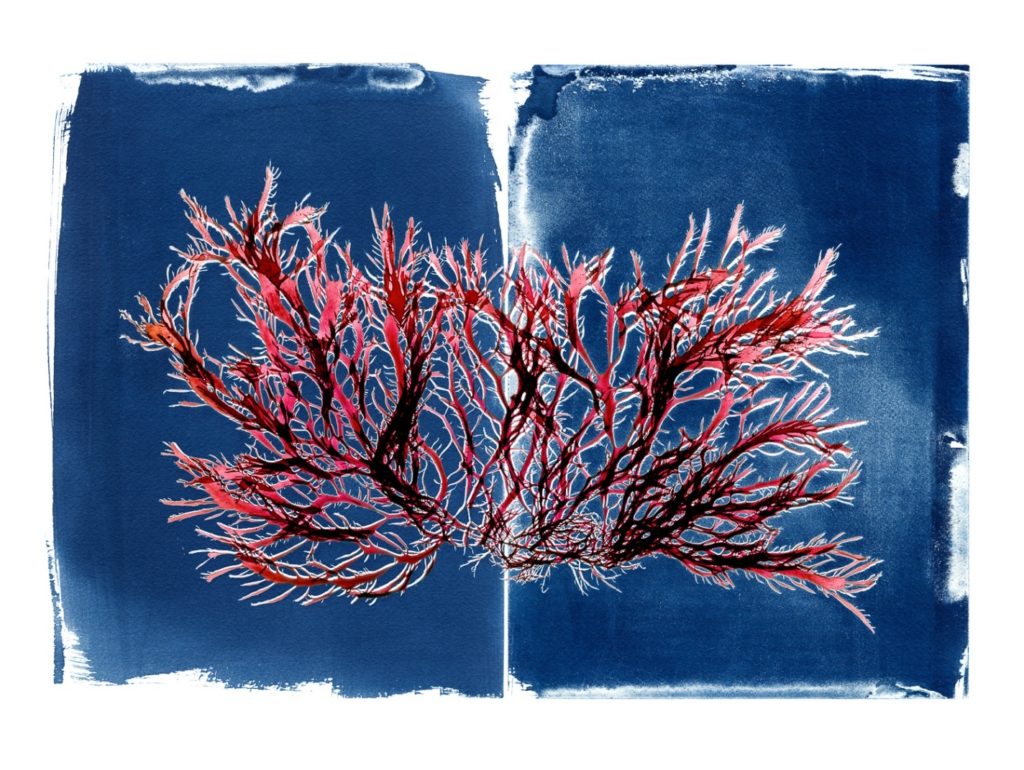
http://www.jonedwardsphotographer.com//Portfolio.cfm?nK=1250
Our friend and mycologist Sue Van Hooks shared these gorgeous shots of a Maine seaweed harvest. In his series “A Life,” Jon Edwards captures a snippet of the world of one of Maine’s seaweed harvesters.
A note from the artist on his approach to documenting these lives:
“These portfolios are of individuals living on islands, either physically or metaphorically, and their environments. There is both simplicity and beauty in the places they inhabit, the lives they live, and the relationships they build within their communities. They are determined to hold on to their lifestyles and family traditions, and to pass on all they have learned to the next generation.
While my work is based in the documentary genre, I look for the mysterious, dark or quiet moments, as well as those that are representative of the lives I photograph. It is my goal to create images that transcend the particular place and person, and share what is common to us all.
During these projects, I left the full-time practice of civil rights and environmental law, and began exploring, in depth, what drives these individuals. What began as an intellectual pursuit, documenting traditional and vanishing ways of life, has instead become a life-changing, artistic journey celebrating these unique individuals and the places they live.”
Our friend and Seaweed Commons collaborator, Larch Hanson, kelp harvester and Maine Seaweed Company founder offers us a treasure trove of seaweed videos on the Maine Seaweed website.
https://theseaweedman.com/videos/
For those of you who have yet to witness a seaweed harvest, there is a short clip of an ocean foam-filled alaria harvest. For those seeking seaweed stories, “The Seaweed Man” video tells Larch’s story of learning to harvest and growing his business and relationship to seaweed, with backdrops of wading boots, self-built boats, and sunrise-on-the-water shots from 4 am harvests.
New or old to the world of seaweeds, may you all rejoice in Larch’s poetics in the “Perennial Plate” episode - and the clip of kelp being unloaded, so slippery and bright you can almost smell it!
“In a universe that’s very tumultuous, the human soul finds a sweet spot, where it can hang for a while… And then finally, when we come out of the ocean and bring the ocean with us, we tuck the ocean inside of our blood stream. We are doing the same dance. We are trying to find a place where we can just hang, with balanced forces.”
Atelier LUMA is a leading algae research community based in France. In December of 2020 Atelier LUMA hosted its first international Algae Summit from Arles, South of France. The summit was host to conversations and debates covering Europe’s Blue Economy road map, science and design with algae-based materials, algal bioremediation, architecture, literature, and art within the algal world. Watch the Algae Summit replay here.
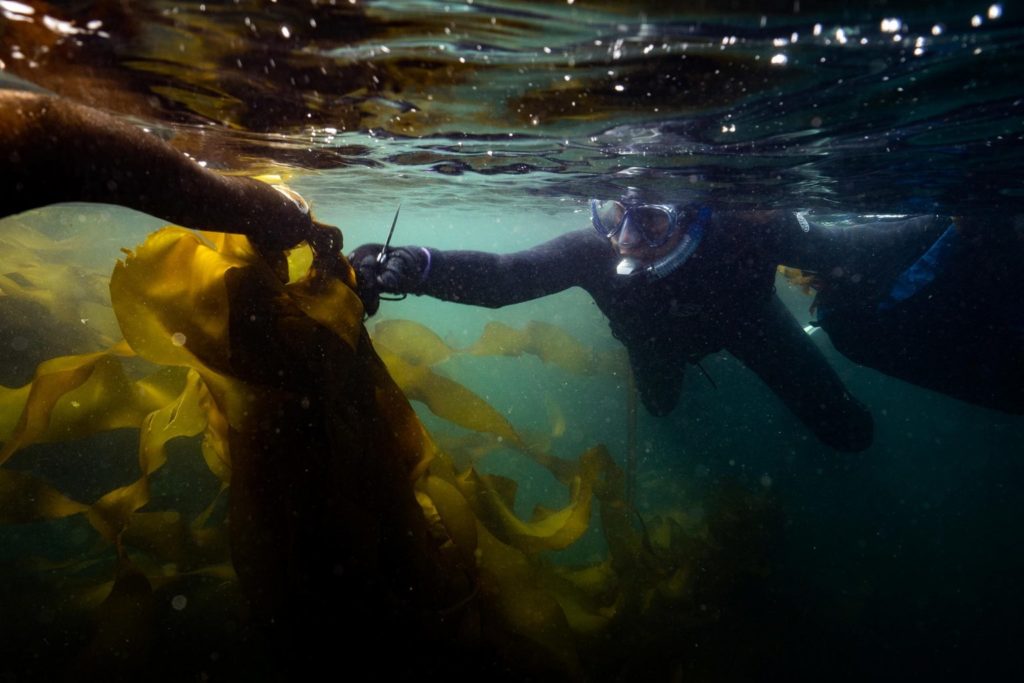
Modern Farmer "How to Harvest Seaweed Sustainably"
Last spring, Modern Farmer published an excerpt from Amanda Swinimer’s book that talked about the best practices for wild harvesting seaweed. Amanda, a wild kelp harvester and member of Seaweed Commons, has been sustainably harvesting seaweeds for twenty years. This article offers her tips on harvesting seaweed with reciprocity, nourishing yourself while promoting the abundance and vitality of those slippery sea vegetables and the ecosystems they sustain.
"Practicing reciprocity is essential to sustainability. In healthy ecosystems, there is a balance of give and take among all of the living organisms. When you harvest seaweeds, you become a member of their ecosystem. What can you give back to an ecosystem after taking something, in order to restore balance? Giving back is personal and can be done in many ways. Taking action on local threats to the ecosystem where I harvest and global threats to the larger ocean ecosystem are ways in which I choose to give back."
Amanda Swinimer The Science and Spirit of Seaweeds
Seaweed Commons wants more folks to get out and explore the world of seaweeds. We believe that the more people know about the power of seaweed and how to care for it, the more widespread a concern for sustainable industry growth will be. We have a few harvest guides up here on the website, but this one is a gem to read - and includes a recipe for Wild Watercress, Kelp and Cauliflower Soup with Crispy Fermented Jerusalem Artichokes - so don’t sleep on it!
Read: Seaweed Handling and Processing Guidelines for Alaska
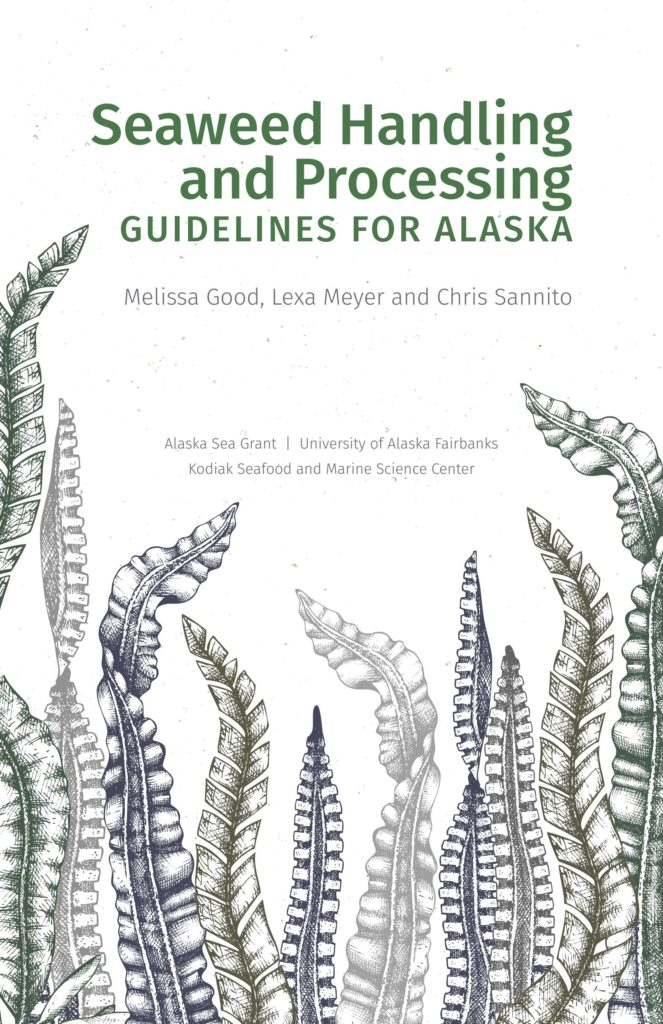
Authors Melissa Good, Chris Sannito, and Lexa Meyer of Alaska Sea Grant - University of Alaska Fairbanks' Kodiak Seafood and Marine Science Center wrote a comprehensive guide for seaweed use in Alaska: Seaweed Handling and Processing Guidelines for Alaska.
We recommend perusing through, even for those of you who are not harvesting or farming seaweed! Their overview of rules and best practices for seaweed harvesting, growing, and processing can help illuminate the magic of seaweed as well as biophysical and mechanical concerns involved in each step of seaweed harvest and processing.
"There is state and federal support for developing Alaska mariculture industries, which could help increase sales of Alaska seaweed, and increase the capacity and capability of new and existing companies involved in purchasing and processing. This guide was developed to help individuals and companies better understand what’s involved as they decide whether to enter the seaweed processing industry, and to provide some industry standards in the manufacturing or processing of kelp." - Introduction to Seaweed Handling and Processing
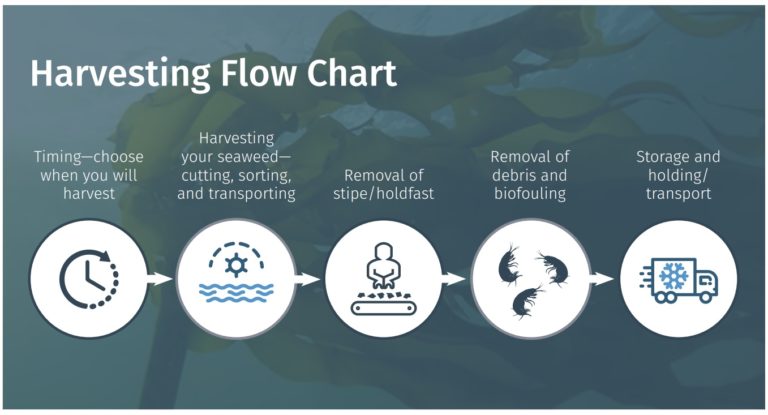
Harvesting excerpt: "Timing for harvest is site dependent, with optimal harvesting conditions occurring when increasing water temperatures decrease biomass quality and quantity. It is important for farmers to understand their site characteristics and know when fouling will start to take place. The harvesting period for a given location ends as rapid increases in water temperature lead to development of epifauna—animals that live on and attach to the surfaces of living organisms— and they can attach to the kelp blades, known as fouling." (p. 41)
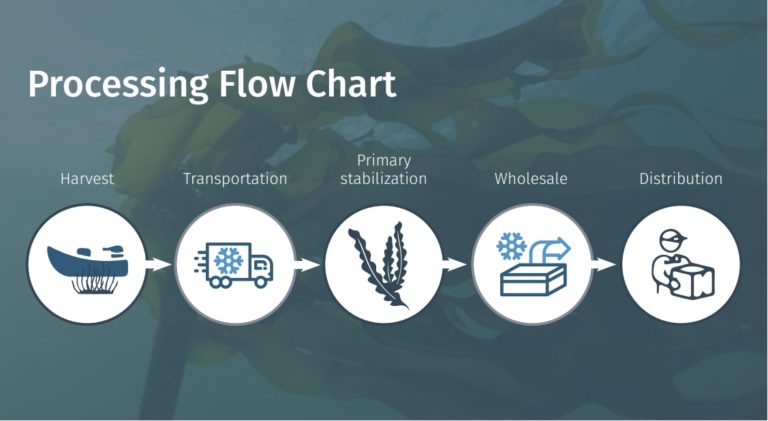
Processing excerpt: "Kelp is typically clean from a microbial standpoint in its natural habitat. Taking steps to keep it this way throughout harvesting, handling, and processing greatly reduces the chances of contamination. It is easier to keep the kelp clean than to decontaminate it at a later step. Depending on the volume of kelp, cleaning equipment can be a simple plastic tub filled with the cleaning solution, a dunk tank, or an industrial-scale vegetable washing machine." (p. 51)
Citation:
Good, M., C. Sannito, and L. Meyer, 2021. Seaweed Handling and Processing Guidelines for Alaska. Alaska Sea Grant, University of Alaska
Fairbanks. Fairbanks, Alaska. https://doi.org/10.4027/shpga.2021
The Sea Gardens Across the Pacific story map shows the importance of revitalizing Indigenous mariculture practices. See the interactive, “living” story map at www.seagardens.net

"Indigenous People have been stewarding the ocean for thousands of years. This stewardship has appeared in many different forms around the world, all of which represent a reciprocal relationship between humans and the sea rooted in deep place-based knowledge. From octopus houses in Haida Gwaii to fish ponds in Hawaiʻi, an Indigenous mariculture renaissance is making waves as groups across the Pacific seek to revitalize these ancient techniques and traditions.
For the first time, information about a multitude of Indigenous cultivation practices has been collected into a cohesive online repository. Sea Gardens Across the Pacific: Reawakening Ancestral Mariculture Innovations is a new interactive, “living” story map that synthesizes knowledge about Indigenous aquaculture throughout the Pacific region, including the west coasts of North, Central and South America, the east coast of Asia, Australia, Aotearoa New Zealand, Oceania and coastlines in between. The project shows these local initiatives are not one-off projects, but rather pieces of a global story. A story that is being told by Indigenous knowledge holders, and further amplified by diverse collaborators who created the story map."
Can Small Seaweed Farms Help Kelp Scale Up?
Lynn Fantom, Civil Eats - 03/16/2022
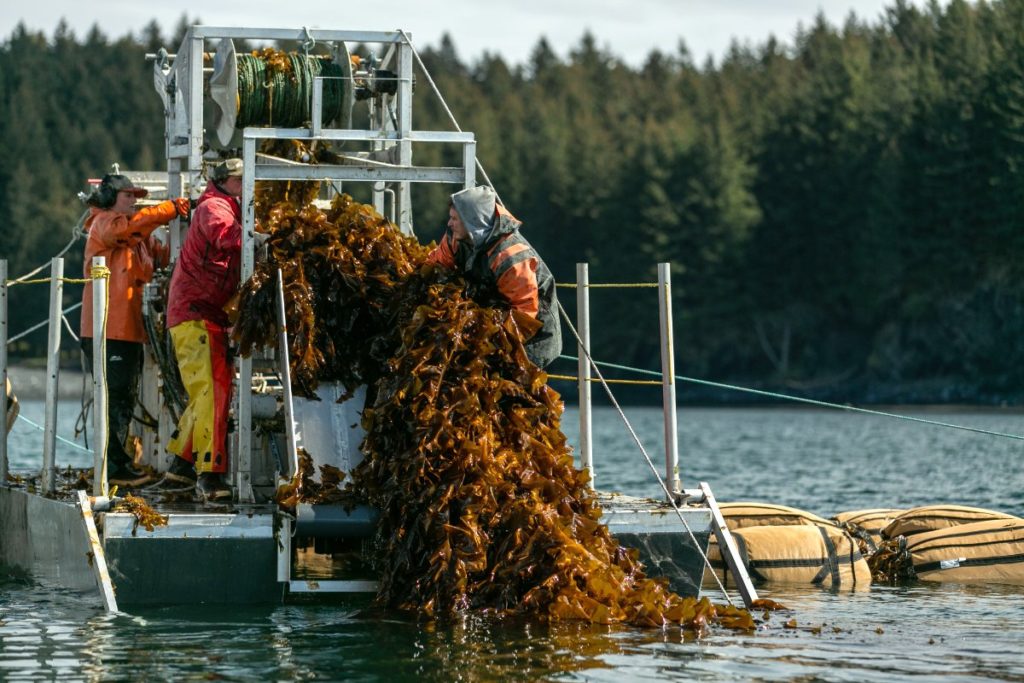
Harvesting Kelp in Alaska. (Photo credit: Rachelle Hacmac). Photo from Civil Eats' article.
Fantom's article explores how companies are capitalizing on US consumers' small, but expanding awareness and demand for seaweed products.
Touching on its capacity as a carbon sink, use as fertilizer, and potential role as methane-reducing livestock feed, the article mostly focuses on edible seaweed and its rising popularity. While some farms are just getting big (especially with Alaska's current permitting regulations), companies like Atlantic Sea Farms are creating a network of small kelp farms by providing seed and a guaranteed market.
This scaling up or "massification" by means of dispersed farms allows more of a sense of stewardship than large, individually owned farms and acknowledges the skill and knowledge of existing farmers.
Seaweed Commons is still asking questions about sizing up the seaweed industry, though. Even with efforts to empower individual farmers, are we ready for a massive increase in kelp demand? If seed is being distributed from a single entity how will biodiversity and genetic integrity be preserved in our inter-tidal kelp forests? Will scaling-up allow for harvest methods that promote rather than deplete seaweed's carbon storage capacity, habitat creation, and everything else it is already doing to "save the world"?
Scotland’s Seaweed Showdown by Cathleen O’Grady

The great spider crab is one species that finds food and shelter in Atlantic Ocean kelp forests. Photo by Nature Picture Library/Alamy Stock Photo
"Garvie Bay is an excellent spot for seaweeds. They coat the intertidal rocks in purple, brown, and near-fluorescent green." Writes Cathleen O'Grady. "McLellan sells some of the seaweeds dried and coarsely ground into chunks as snacks or flavorful additions to soups and stews; others she sells fresh to seafood companies that supply restaurants. But lately, the tangles of kelp that darken the water below the tideline have been commanding her attention for different reasons.
In August 2018, a Scottish company called Marine Biopolymers proposed the first-ever industrial-scale harvest of kelp from Scotland’s wild and watery forests—including those here at Garvie Bay. The company argues that because kelp regrows quickly, the project would be an eco-friendly economic boon."
In a piece about Scottish highlanders' responses to an industrialization kelp farming, O'Grady profiles Ailsa McLellan, a small-scale wild seaweed harvester and community organizer. The campaign opposing Marine Biopolymers' proposal brought together the youth-led environmental group Ullapool Sea Savers, Fishermen Associations, activists like David Attenborough, scientists and other community members.
Their organizing led to the passage of a 2018 amendment in the Scottish Parliament which bans "any commercial harvest method that would harm the regrowth of individuals—including dredging." This amendment prevented Marine Biopolymers' proposal from going any further. While folks across Scotland have mixed feelings towards the particular order of events and the politics behind it, the impact made by community members is clear - and inspiring for all of us seaweed lovers.
O'Grady ends the article with an acknowledgment of the movement towards a land and intertidal commons in the Highlands:
"In the past few decades, the people of the Scoraig peninsula have steadily reforested the land. Along with the handful of Highlands communities that have bought their land from wealthy landowners and now manage it in community trusts, their vision of Scotland’s natural resources is one of shared ownership and shared benefit."
Read on and enjoy!! - Cathleen O'Grady's full article is at Hakai Magazine - 17/03/2020
The Curious World of Seaweed by Josie Iselin is available for pre-order from Heyday Books.
“The Curious World of Seaweed, was released by Heyday Books in August 2019. It is an award-winning, spectacular specimen of a book—a deep dive into the history and science of the iconic seaweeds and kelps of the Pacific Coast and beyond; it is full of visual treasure and engrossing narrative, including stories of the many pioneering women scientists whose research and work in the world of marine algae has advanced our understanding of the oceans. Beach Stones and Seashells have become beach combing classics, and her little Heart Stones is a must for anyone thinking about love!”
Using British admiralty charts from 1858-1956, research team has created digital map of coastal kelp
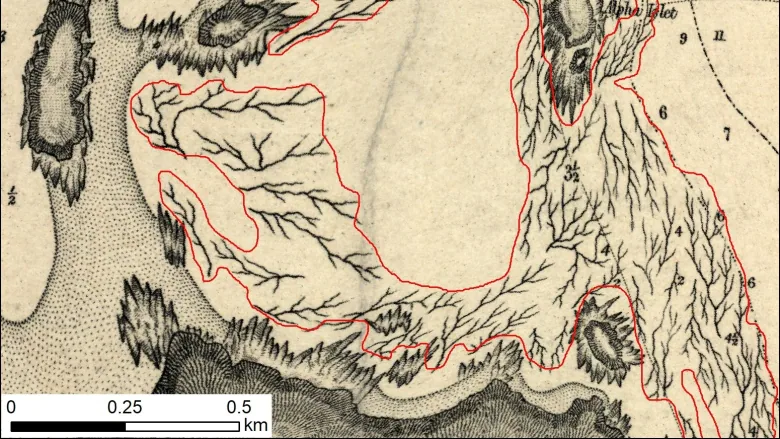
A serendipitous meeting between a professor and a colleague last year led to a treasure trove of historical maps that indicated kelp bed locations off British Columbia's coast, helping experts understand the changes in what are known as the "rainforests of the ocean."
Using those British admiralty charts from 1858 to 1956, Costa and her research team have now created the first historical digital map of B.C.'s coastal kelp forests.
They'll use the maps to further investigate the loss of the kelp beds in research supported by Fisheries and Oceans Canada, Canadian Hydrographic Service and the Pacific Salmon Foundation, she said.
"Kelp was considered a navigational hazard, so the British carefully annotated all kelp forests on their charts,'' Costa said. "And the historical charts increase our understanding of kelp distribution over time.''
